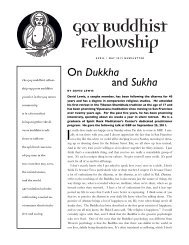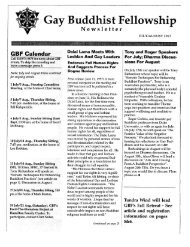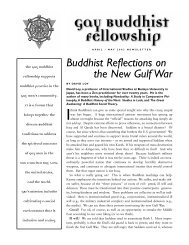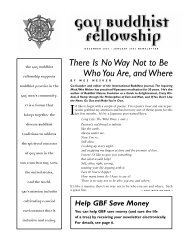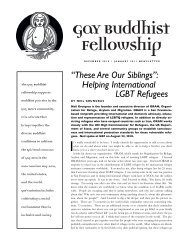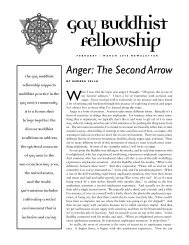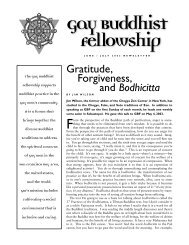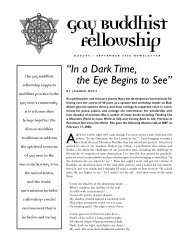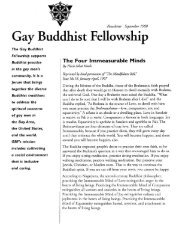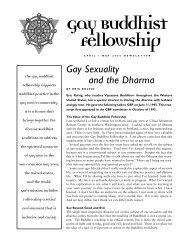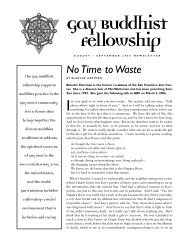2008.06 James Baraz (Awakening Joy).pdf - Gay Buddhist Fellowship
2008.06 James Baraz (Awakening Joy).pdf - Gay Buddhist Fellowship
2008.06 James Baraz (Awakening Joy).pdf - Gay Buddhist Fellowship
You also want an ePaper? Increase the reach of your titles
YUMPU automatically turns print PDFs into web optimized ePapers that Google loves.
<strong>Gay</strong> <strong>Buddhist</strong><br />
<strong>Fellowship</strong><br />
J U N E / J U L Y 2 0 0 8<br />
N E W S L E T T E R<br />
The <strong>Gay</strong> <strong>Buddhist</strong><br />
<strong>Fellowship</strong> supports<br />
<strong>Buddhist</strong> practice in the<br />
<strong>Gay</strong> men’s community.<br />
It is a forum that<br />
brings together the<br />
diverse <strong>Buddhist</strong><br />
traditions to address<br />
the spiritual concerns<br />
of <strong>Gay</strong> men in the<br />
San Francisco Bay Area,<br />
the United States,<br />
and the world.<br />
GBF’s mission includes<br />
cultivating a social<br />
environment that is<br />
inclusive and caring.<br />
<strong>Awakening</strong> <strong>Joy</strong><br />
BY JAMES BARAZ<br />
<strong>James</strong> <strong>Baraz</strong> has practiced Vipassana meditation since 1974 and taught<br />
since 1980. He is a founding teacher of Spirit Rock Meditation Center.<br />
<strong>James</strong> coordinates both the Community Dharma Leader program and the<br />
Kalyana Mitta Network, and he is the teacher-advisor to the Spirit Rock<br />
Family and Teen program. In addition, he is on the International Advisory<br />
Board of the <strong>Buddhist</strong> Peace <strong>Fellowship</strong>. <strong>James</strong> leads an ongoing meditation<br />
class in the East Bay and is increasingly known for his repeating 10-<br />
month experiential course ‘<strong>Awakening</strong> <strong>Joy</strong>’ that that has helped develop<br />
the natural capacity for well-being and happiness for over 1500 people in<br />
numerous countries. He spoke to GBF on November 11, 2007.<br />
Iwant to talk about this subject that’s been a focus of mine for the last few years.<br />
This year I’m writing a book, which is for me my first book. The essence of the<br />
topic is the Buddha dharma as a path of happiness, although it’s not solely geared<br />
to dharma practitioners. The course that I teach and the name of the book is <strong>Awakening</strong><br />
<strong>Joy</strong>. I’ll say a little about my own journey with the <strong>Buddhist</strong> path as far as<br />
happiness goes, and then share a little with you about what I’ve been experimenting<br />
with the last few years.<br />
I am so deeply indebted and grateful to the Buddha and the dharma and certainly<br />
the sangha for showing me possibilities of real happiness. And at times I have<br />
gotten to be a serious practitioner. If you consider yourself to be a serious practitioner,<br />
it’s a double-edged sword. I don’t know if “sword” is the right word, but it’s<br />
a blessing and a curse. If you’re very dedicated and sincere, and your heart is in it<br />
and you’re inspired, sometimes we can get very serious. As one of my teachers said,<br />
he got dead serious in his practice. And there can be so much emphasis on the first<br />
noble truth on suffering, and even when the Buddha was asked what he taught, he<br />
said, “I teach about suffering and the end of suffering.” You don’t hear too much<br />
about happiness; you hear about suffering and the end of suffering. And yet the<br />
Buddha was called the Happy One. And that’s what the end of suffering is, the highest<br />
path he gave us. And he did say, “If you aim for the highest happiness, all the<br />
other levels of happiness become available to you.” The Dalai Lama starts out his<br />
book The Art of Happiness by saying, “The purpose of life is to be happy.” It’s a<br />
great opening line for a book. I’ll read that one!<br />
But we can, as I say, get a little bit sidetracked in the seriousness and solemnity of<br />
practice. There are some reasons why this can be so, why there can be a misunderstanding<br />
of the teaching. I, for one, after having been inspired for a number of years<br />
in my heart and with my whole being on fire for waking up, got into a dark period<br />
for some time. I misunderstood some aspects of the teachings, and I’ll share with you<br />
a couple of ways this misunderstanding can come. This one principle of inspiring
one’s practice is what’s called samvega. This is the definition<br />
of samvega: “The oppressive sense of shock, dismay, and<br />
alienation that comes with realizing the futility and meaninglessness<br />
of life as it is normally led. A chastening sense of one’s<br />
own complacency and foolishness in having let oneself live so<br />
blindly and an anxious sense of urgency in trying to find a way<br />
out of the meaningless cycle.” How does that grab you?<br />
Now this is actually, when understood, a very important<br />
concept because we have to be motivated in some way to get<br />
off our complacency in thinking, “Oh, well, maybe this will<br />
make me happy, or maybe this will make me happy.” But it’s<br />
also easy to understand that as seeing life as a drag and thinking,<br />
“Let’s get out of here as quickly as we can.” The operative<br />
phrase in that definition is “realizing the futility and<br />
meaninglessness of life as it’s normally lived.” But you can<br />
kind of skip over that part and just say, “Yeah, life is meaningless<br />
and futile, and I want to get out.”<br />
I sat with a group of a Burmese master who in every talk<br />
would say, “May you speedily attain Nirvana and get off the<br />
wheel of samsara.” And he was saying it from a very loving<br />
and compassionate place, but I kept on hearing, “We’ve got<br />
to get out of this place.” And then there’s another concept<br />
that can create the sense of getting out and life is a drag. Is<br />
anyone familiar with the term nibbida? I’ll read to you one<br />
translation: “Seeing things directly as they are and seeing<br />
what is impermanent as impermanent with right view, therefore<br />
one should abide in utter disgust for the aggregates, the<br />
aggregates being this mind-body process.” And another<br />
translation: “With a practitioner’s practice in accordance with<br />
the dharma, he should dwell in gross revulsion toward the<br />
aggregates.” You hear that? No wonder there’s this sense of<br />
life is not fun, and it’s not okay to feel good about life.<br />
Actually, those are incomplete translations of the word nibbida<br />
because what the word means actually is disenchantment,<br />
and when you are disenchanted, it’s like you’re breaking<br />
the spell of enchantment, of being enthralled by this or by<br />
that, or by this mind-body process, or other mind-body<br />
processes out there. Disenchantment, breaking the spell of<br />
that enthrallment, is very different from utter disgust and<br />
revulsion. But in my own confusion, I heard those terms and<br />
got the sense that we should have utter revulsion for mindbody<br />
process and that everything is meaningless, and I went<br />
through this dark period for a while because I love to celebrate<br />
life, and I’m a very passionate and intense person. Fortunately,<br />
I got intense about something that pulled me out of<br />
this. And that’s meditation. But for quite a while, I went<br />
through this inner conflict about letting my devotion, my<br />
bahkti nature, come out, and I thought that I wasn’t being a<br />
good <strong>Buddhist</strong> if I was enjoying my life.<br />
This went on for a while, and actually what really woke me<br />
up from that trance was being around a teacher named Papajee.<br />
I went to India in 1990, and he talked about emptiness<br />
all the time. Empty—it’s all empty. But he had this incredible<br />
love and brightness and delight and joy, and I asked him<br />
lots of questions. “Give me all your questions, all your questions.”<br />
And near the end of my visit, I said, “I have one question,<br />
Papajee.” “Give me your question.” I said, “You know,<br />
when <strong>Buddhist</strong>s talk about emptiness, it’s so serious, so<br />
solemn and heavy. Yes, we have to realize emptiness. When<br />
you talk about emptiness, you’re laughing, you’ve got an aura<br />
of love and there’s this tremendous energy that comes out<br />
from you. Why is your emptiness so much more fun than<br />
what I’m used to hearing and talking about?”<br />
And he said, in essence, “If you have touched something<br />
very profound in the stillness of meditation, it can easily be<br />
equated that stillness is where the depth of awakening is, and<br />
that the emptiness is about that stillness, and anything other<br />
This is right effort: when you’re feeling in the middle of a<br />
wholesome state, it’s skillful to maintain and increase that feeling<br />
of well-being.<br />
than that stillness, the world of vitality and appearances, can<br />
seem antithetical, so you can get lost in this idea of the profundity<br />
being equated with stillness, which is serious and<br />
solemn.” He said, “My emptiness rejects nothing. There is<br />
love and there’s confusion, and there’s joy and there’s intensity.<br />
Nothing is rejected from my emptiness.” And then he<br />
laughed: “Ha, ha, ha!”<br />
I said, “That’s it. I’ve been misled.” Because that’s exactly<br />
what in my heart I think of as the totality of life, that there’s<br />
nothing excluded. And it actually brought me back to my original<br />
joy of the dharma. I was looking at it through a narrow<br />
lens of a particular Burmese Theravadan slant, through one<br />
particular approach, and I started to look back and say, “Well,<br />
wait a second, what did the Buddha really teach?” Because if<br />
he got that whole truth, there must be something more than just<br />
getting out of this miserable existence. And I started to look at<br />
his teachings and see that there are many aspects of the <strong>Buddhist</strong><br />
teachings that point to joy and happiness. <strong>Joy</strong> is one of<br />
the seven factors of enlightenment, one of the four Brahma<br />
Viharas, along with loving-kindness, compassion, and equanimity.<br />
It’s a factor in awakening. In one list, he talks about<br />
suffering being the causative factor of faith, faith being a<br />
causative factor for gladness, gladness being a causative factor<br />
for joy, which is a causative factor for happiness, contentment,<br />
equanimity, all the way up to full awakening.<br />
There are many, many different flavors from piti (rapture)<br />
and pamoja (delight) and suka (happiness), and I started to<br />
see, “Well, wait a second, as Thich Nhat Hanh says, “Suffering<br />
is not enough. You can’t just stop there.” Okay, I understand<br />
suffering and the end of suffering. You’ve got to see that<br />
what opens my heart and makes me connect with life makes<br />
me want to be participating in life because if it’s only about<br />
getting out of suffering, it’s a very insular and limited focus. So<br />
I started to look at these teachings and reformulate them, and<br />
there are some incredibly powerful teachings that I’ve been<br />
using through these last few years in this course that I teach.<br />
First, there are three principles that are the essence of my<br />
2 GBF J U N E / J U L Y 2 0 0 8 N E W S L E T T E R
exploration. The first principle has to do with Right Effort.<br />
You might think, “Oh, that doesn’t sound very fun.” There<br />
are four Right Efforts in the classical teachings. Two have to<br />
do with unwholesome states, guarding against unwholesome<br />
states that haven’t arisen, and overcoming unwholesome<br />
states that have arisen. It’s very useful, good stuff, and we’re<br />
probably very familiar with those.<br />
And the two other aspects of right effort are about wholesome<br />
states, developing wholesome states that have not yet<br />
arisen, like loving-kindness or compassion or equanimity, etc.<br />
The fourth is maintaining and increasing wholesome states<br />
when they have arisen. This is right effort: when you’re feeling<br />
in the middle of a wholesome state, it’s skillful to maintain<br />
and increase that feeling of well-being. In a little known discourse,<br />
the Buddha says, “In the middle of an act, in the middle<br />
of a wholesome state, tune into it,” and the words are, “Be<br />
generous.” He says in the middle of being generous, it’s useful<br />
to say to yourself, it’s skillful to say to yourself, “I’m being generous<br />
right now.” Then the words are, “Thinking I’m generous,<br />
one gladdens the heart, one delights in the meaning, one<br />
gains inspiration in the meaning and in the dharma.”<br />
Now, he’s not saying, “Check it out, aren’t I a generous<br />
guy?” All you’re doing then is reifying a sense of self. But he<br />
is saying, “Feel how good it feels for that impulse of generosity<br />
to move through you.” And as you tune into it, you actually<br />
experience a kind of gladness. And then the line in this<br />
discourse is, “That gladness connected with what is wholesome,<br />
I call an equipment of mind for overcoming ill-will and<br />
hostility.” I’ll say it again. In the wholesome state, you feel this<br />
gladness, and he says, “That gladness that arises, that gladness<br />
connecting with the wholesome, I call an equipment of mind<br />
another discourse, is very straightforward and I think very<br />
profound. He says, “Whatever the practitioner frequently<br />
thinks and ponders upon, that will become the inclination of<br />
their mind.” Can you argue with that? Whatever you frequently<br />
think and ponder upon will become the inclination of<br />
your mind. If you practice seeing how life is a drag and everyone<br />
around you disappoints you, you’ll get ample confirmation.<br />
If you practice seeing that there is a lot of goodness in<br />
life, there’s beauty around and goodness in people, or that it<br />
feels good to be generous or kind, that becomes the inclination<br />
of your mind.<br />
And now in the last decade or so, current brain research is<br />
corroborating this. This is not news, but it’s very clearly substantiated.<br />
You can measure these synaptic connections and<br />
neural pathways that lead to a great sense of well-being, and<br />
you deepen your mediation practice, and as you practice certain<br />
states of well-being, you kind of suppress the amygdula,<br />
which gets activated in fear very easily and leads us to agitation<br />
and unskillfulness and confusion.<br />
So as I said I was looking into this for a while, and getting<br />
really really intrigued by it, and along the way as I was exploring<br />
this, my wife gave me a book—this was in 1999—for my<br />
birthday, and it’s a book not by <strong>Buddhist</strong>s, but by two guys<br />
who became friends. They are a couple, Rick Foster and Greg<br />
Hick, and their book is called How We Choose to Be Happy.<br />
They’re corporate facilitators and organizational people. But<br />
they decided to explore happiness because they said the people<br />
they worked with were some of the most unhappy people.<br />
Rick said, “Let’s write a book on what we do.” Greg said,<br />
“Who wants to be around unhappy people?” Then Rick said,<br />
“Well, let’s check out happy people.” And they spent the next<br />
The Buddha says,“Whatever the practitioner frequently thinks<br />
and ponders upon, that will become the inclination of their<br />
mind.” Can you argue with that? Whatever you frequently<br />
think and ponder upon will become the inclination of your<br />
mind. If you practice seeing how life is a drag and everyone<br />
around you disappoints you, you’ll get ample confirmation. If<br />
you practice seeing that there is a lot of goodness in life, there’s<br />
beauty around and goodness in people, or that it feels good to<br />
be generous or kind, that becomes the inclination of your mind.<br />
to overcome ill-will and hostility.” It’s in your tool kit to overcome<br />
anger and any kind of negativity, to feel that gladness.<br />
He says this is a really good thing. I thought, “Oh, far out. So<br />
it’s okay not only to feel good, it’s skillful to feel good if that<br />
feeling good is connected with really wholesome things.”<br />
Then there’s a third principle. First is maintaining and<br />
increasing wholesome states. Second is experiencing the gladness<br />
that arises with them. And then the third principle, in<br />
three years interviewing three hundred plus people, identifiable,<br />
certifiable, extremely happy people.<br />
And they go to a town in rural Alabama, for instance, and<br />
go to the diner, and say, “Who’s the happiest person in town?”<br />
And people at the diner would agree, “Oh, Shirley, she’s the<br />
happy one.” They’d go to Shirley and ask, “Well, are you<br />
happy?” “Yeah, pretty happy.” “Can we ask someone who<br />
might know you in a different light?” They’d ask one of her<br />
GBF J U N E / J U L Y 2 0 0 8 N E W S L E T T E R 3
co-workers or family members. “Yeah, Shirley is pretty<br />
happy.” Then they’d have an in-depth interview. “Why are<br />
you so happy?” And after three years, and researching all<br />
these people, they distilled nine common denominators that all<br />
these people had, consciously or unconsciously. And that’s the<br />
book, these nine secrets, these nine choices of extremely happy<br />
people. And I read this, and it’s a very fun, delicious book. It’s<br />
the book that I use for the course until mine is written. They<br />
now give me credit and acknowledge me in the acknowledgment<br />
section because they’ve sold a whole lot of books because<br />
of me. And they’ve come to Spirit Rock, etc. etc. And I said,<br />
“Okay, all of these or most of these are <strong>Buddhist</strong> principles,<br />
just about all of them.”<br />
And I wanted to do something with my Berkeley group. If<br />
you’re ever in Berkeley on Thursday nights, please come and<br />
sit with us. The information is in the Spirit Rock newsletter.<br />
I said, “Okay, folks, I want to explore happiness, and we’re<br />
going to look at these principles, but I’m going to speak about<br />
them through a dharma lens, and through Buddha dharma.”<br />
They don’t have practices, exactly, and that’s one of the wonderful<br />
things about Buddhism, the practices. I said, “We’re<br />
going to do this for the next three months. And we got happier<br />
and happier and happier.” Not everyone. There was one<br />
person who just said, “I can’t stand any more of this happiness.”<br />
And she had a hard time.<br />
But most everyone was just not only getting the ideas, but<br />
we were doing practices, and I said, “This is far out.” So I<br />
started to write at that point. This was a while ago, and in<br />
the writing, I said, “I’m going to do a course and I’m going to<br />
test out the theories with people who don’t come to me for sittings,<br />
and sit with you who maybe aren’t even <strong>Buddhist</strong>s,”<br />
and I started doing these <strong>Awakening</strong> <strong>Joy</strong> courses which started<br />
out as six months. It’s now ten months, using not just the<br />
principles that they use. Actually, there are ten principles,<br />
some of them are in here, and some of them aren’t. But<br />
I can’t do ten months in ten minutes, but in the remaining<br />
time, I just want to give you a little bit of the sense of it.<br />
First, let’s talk about inclining the mind toward the wholesome.<br />
There are many different wholesome states. It starts<br />
with the intention to be happy. This is not one that comes<br />
naturally to many people. We might have the intention to be<br />
successful or to be loved or to have all kinds of wonderful<br />
things happen to us that make us feel good, but to start out<br />
with the intention to be happy, that’s the first choice that these<br />
people had. And you have to really get clear on that because<br />
if your intention is other than that, you won’t necessarily<br />
arrive where you want to be. You might have the intention to<br />
be a very dedicated practitioner, but if happiness isn’t in<br />
there—the Dalai Lama said, “The purpose of life is to be<br />
happy.” Then you can get very serious in thinking, “Oh, yes,<br />
I’m a <strong>Buddhist</strong> meditator, and this is good for me. I know it’s<br />
good for me. It doesn’t feel so good, so it must be good.” To<br />
get in touch with the intention for great well-being is not only<br />
a gift to yourself but to everyone that you meet, because the<br />
more you’re in touch with your own goodness, the more it<br />
shines through. So if you’re depriving yourself and being a<br />
martyr, or being some very serious practitioner or some idea<br />
of what you think a practitioner should look like, and not<br />
going for what your heart says real happiness is, you’re going<br />
to be missing something. Now the key is to see where real<br />
happiness lies. As that samvega quote says, “Real happiness<br />
does not lie in getting the next goodie as quickly as you can.”<br />
And we are subject to tremendous mind manipulation. We<br />
have to counteract these messages. As an example, this is an ad<br />
that just typifies what we’re up against. It’s called the Gold<br />
Shivers. A beautiful woman in a two-page ad—someone gave<br />
me this a while ago. “The Gold Shivers, that electric excitement,<br />
that thrilling warmth. Every piece of gold jewelry ignites<br />
it once again. Nothing makes you feel as good as gold.” This<br />
is the second part. “What is the real substance of a new piece<br />
To get in touch with the intention for great well-being is not<br />
only a gift to yourself but to everyone that you meet, because<br />
the more you’re in touch with your own goodness, the more it<br />
shines through.<br />
they’re what I’ve seen as the <strong>Buddhist</strong> path of happiness. In<br />
the first course, there were two groups of twenty, and then in<br />
the next one—people told people—there were a hundred, and<br />
the next one had two hundred, and the next one had five hundred.<br />
People can do it online. It’s not just live; you couldn’t<br />
have 500 people live. This one has 700 and people are doing<br />
it in New Zealand, and England, and all over the place.<br />
We do one theme a month, a wholesome state, with supportive<br />
practices, meditation, and things like that. There’s no<br />
pressure, no guilt, no failing. Singing every day really makes a<br />
difference. You won’t find that in the Pali canon! I didn’t find<br />
that there. Using your body regularly. Having a buddy to<br />
connect with. A gratitude practice, and things like that. And<br />
it works, if you’ve got the intention, it works.<br />
of gold jewelry? Emotion, pure and powerful from the first<br />
small shiver of excitement when a shimmering necklace of gold<br />
beads captures a woman’s eye, to the great shivers of delight<br />
when the coveted object actually becomes hers. Among life’s<br />
pleasures, count this deeply felt euphoria as unique. The only<br />
way to get the Gold Shivers is by getting the gold.”<br />
According to a book called Culture Jam, the average American<br />
gets 3,000 messages like this every day through media,<br />
billboards, whatever, saying, “This is going to make you<br />
happy.” So the Buddha was radical to say, “Where does happiness<br />
really lie?” In fact, you might know that he was motivated<br />
to teach when he became enlightened, and he saw that<br />
everyone wants to be happy, and most everyone is doing<br />
exactly the things that will lead to more suffering. And that’s<br />
4 GBF J U N E / J U L Y 2 0 0 8 N E W S L E T T E R
what motivated him. We’re looking in all the wrong places.<br />
So I’ll give you a taste of one practice. I’ll mention some of<br />
these practices and some of the themes, starting with Intention.<br />
Mindfulness, noticing what is good around you, is a<br />
very important practice. As you incline the mind, it doesn’t<br />
mean that you’re pretending everything is hunky dory. You<br />
don’t want to live in dreamland, naively, but if you keep on<br />
looking for what’s good, you’ll find it, not only in things but<br />
in people and in yourself. For instance, if someone comes into<br />
a room and they see all of your flaws, how do you feel?<br />
Flawed, don’t you? Exposed, vulnerable, whatever. You can<br />
get a sense that judgmental mind has a loud radar on it.<br />
Someone else might come into a room and they might know<br />
all your flaws, but they are seeing and you can sense they’re<br />
seeing how beautiful you are. How do you feel? Beautiful,<br />
don’t you? Or Buddha-full. That’s why it’s so great being<br />
around the Dalai Lama, because he’s seeing everyone as a<br />
Buddha, and you start feeling, “Hey, maybe he’s right. Maybe<br />
I am a Buddha.” So that’s one thing, to incline the mind and<br />
look for what’s good and what’s uplifting. It allows you to<br />
hold all the sorrows. I’m sure you know the Ten Thousand<br />
<strong>Joy</strong>s and the Ten Thousand Sorrows. If you’re only looking<br />
for what’s wrong, it’s a very despairing view, but if you open<br />
up to all the joys, it allows you to hold and make the space<br />
for all the sorrows.<br />
Another one of these wholesome states themes is embracing<br />
our suffering as a path to joy, which is this list of suffering leading<br />
to faith. There are ways that you can hold your suffering<br />
that aren’t in denial but that process it and lead to even deeper<br />
understanding and compassion. There is the joy that comes<br />
from loving God, and there are many aspects of that. Or the<br />
joy that comes from what the Buddha called the Bliss of Blamelessness—acting<br />
with integrity, and how good that feels. And<br />
so with each wholesome state, whether or not you do this<br />
course, there’s something you might take with you when you’re<br />
feeling you’re acting with real integrity and you take the high<br />
road. As he suggests, let yourself feel how good it feels. This<br />
is good. You’re doing good now. And as you let it register in<br />
your awareness and in your body, there’s a sense of well-being<br />
that is extraordinary and overcomes ill will and hostility.<br />
There is the well-being of course that comes from lovingkindness,<br />
and that’s a practice, and service, and equanimity.<br />
There’s well-being that comes from gratitude. As I close, I’ll<br />
do a little bit of a gratitude exercise. So just notice how it feels<br />
inside. So just close your eyes for a moment.<br />
Just go inside and think of someone or something that<br />
you’re grateful for in your life. You might have an image of<br />
them or that situation, and let that picture be even bigger so<br />
You can train your mind and heart to go anywhere. If you don’t<br />
train it, it will go down the habitual pathways that are usually<br />
tinged with grief, hatred, and delusion....The Buddha said the<br />
source of our happiness is getting in touch with states that<br />
come from non-greed or generosity, or the ability to let go,<br />
generosity being the most positive expression of that. Nonhatred<br />
or kindness, basically kindness. Non-delusion or clarity<br />
or wisdom. Those are the sources of happiness.<br />
you can connect with them. And you might just feel the blessing<br />
of that. Notice how it feels in your body. Perhaps silently<br />
say even to that person or to life, I’m so grateful for this.<br />
I’m really grateful to you for this. Just grateful to you.<br />
Now let your awareness feel what it feels like to feel that<br />
gratitude, how good it feels. And bring someone else to mind<br />
and many, many blessings. Buddha has this beautiful discourse<br />
on blessings. Bring someone else or something else to<br />
mind that really opens you. Appreciate the blessing in your<br />
life. Have an image. And once again, express silently the<br />
gratitude to that person or to life for that. Let yourself<br />
breathe that in and just relax into that sense of gratitude and<br />
how it feels. Let your awareness really tune into the wholesomeness,<br />
that gladness of the wholesome. Then very gently<br />
as you come out, stay connected to that space, whatever<br />
you’ve touched. Did you feel something?<br />
You can incline your mind anywhere. That’s the whole<br />
point. You can train your mind and heart to go anywhere. If<br />
you don’t train it, it will go down the habitual pathways that<br />
are usually tinged with grief, hatred, and delusion. That’s just<br />
the way it happens to often be. Or attachment, aversion, and<br />
ignorance. If you do train it to see where it really feels good,<br />
then Buddha said the source of our happiness is getting in<br />
touch with states that come from non-greed or generosity, or<br />
the ability to let go, generosity being the most positive expression<br />
of that. Non-hatred or kindness, basically kindness.<br />
Non-delusion or clarity or wisdom. Those are the sources of<br />
happiness. So all of the training is to develop those. The Buddha<br />
said, “If it were not possible to free the mind of greed,<br />
hatred, and delusion, I wouldn’t tell you to do so. But it is<br />
possible.” So this is what I’ve been exploring for the last few<br />
years and it’s just so exciting to know we can train ourselves<br />
not to be automatons on the cushion, but to more and more<br />
come from that place in our daily life.<br />
■<br />
GBF J U N E / J U L Y 2 0 0 8 N E W S L E T T E R 5
G B F<br />
STEERING COMMITTEE<br />
Ray Dyer<br />
Clint Seiter<br />
Marvin Snow<br />
Jim Stewart<br />
Carl Wolf<br />
TREASURER<br />
Teng-How Bae<br />
NEWSLETTER<br />
Editor<br />
Michael Langdon<br />
Design / Layout<br />
Michael Gabel<br />
Transcribers<br />
Bill Chiles<br />
Ray Dyer<br />
Gary Pedler<br />
Dan Rosnik<br />
Mailing List<br />
Todd Pope<br />
Robin Levitt<br />
Newsletter Mailing<br />
Jack Busby<br />
MAIL<br />
Bill Chiles<br />
LARKIN STREET<br />
YOUTH CENTER<br />
Volunteer Coordinator<br />
Clint Seiter<br />
Bill Weber<br />
PRISON OUTREACH<br />
Coordinator<br />
Baruch Golden<br />
WEBSITE<br />
Joe Kukulka<br />
YAHOO GROUP MODERATOR<br />
George Hubbard<br />
SUNDAY SITTINGS<br />
Program Committee<br />
Dean Bellerby<br />
Howard DePorte<br />
Baruch Golden<br />
Jerry Jones<br />
Gary Pedler<br />
Jim Stewart<br />
Speaker Coordinator<br />
Jerry Jones<br />
Facilitator Coordinator<br />
Ray Dyer<br />
Facilitators<br />
Peter Camarda<br />
Peter Dell<br />
Ray Dyer<br />
Joe Goode<br />
Marvin Snow<br />
Host Coordinator<br />
Kei Matsuda<br />
Hosts<br />
Cass Brayton<br />
Jay Corbett<br />
Peter Dell<br />
Richard Hedden<br />
Mark Hoffheimer<br />
Dave Limcaco<br />
Kei Matsuda<br />
Todd Pope<br />
Oscar Saginoya<br />
Paul Shepard<br />
Marvin Snow<br />
Harv Whitten<br />
Larry Wisch<br />
Nobu Yamaji<br />
Sound / Recordings<br />
George Hubbard<br />
Retreat Coordinator<br />
Michael Murphy<br />
June 14—Mount Tamalpais<br />
Steep Ravine Hike<br />
Come join GBF this June 14 (Saturday) on a hike under the shade of the redwoods and<br />
by a series of cascades down Steep Ravine trail on Mt. Tam. This is an easy 3-4 mile<br />
hike, all downhill, that ends in the town of Stinson Beach. We'll hang out in Stinson<br />
Beach, have lunch in one of the cafes, and then drive back up to the parking lot. Nature<br />
and the comforts of civilization, all in one day. Who could ask for more?<br />
Hikers will meet in front of 37 Bartlett St. at 9:30. (Yes, I know that's early, but the<br />
parking lot at the trailhead gets full quickly, and we have to be there early.) Bring sunscreen,<br />
sturdy shoes and water. Rain cancels.<br />
For further information, call Clint at (415) 271-2780.<br />
July 12—Mount Tamalpais<br />
Sun and Redwood Hike<br />
Now that we've hiked Steep Ravine, let's do a higher altitude hike on Mt. Tamalpais as<br />
well. Just a half hour north of San Francisco, Mt. Tam offers some of the most spectacular<br />
hikes in the Bay Area. This particular hike will be about 4 miles long, with modest<br />
gradient increases and decreases. The first half will be in exposed areas offering sweeping<br />
views of the Pacific and San Francisco off in the distance. We'll loop back through<br />
the redwoods, in shade. Pack a lunch, water, sunscreen and a jacket (in case it gets<br />
breezy). We will meet in front of the GBF center (37 Bartlett St.) at 10:00 a.m. and carpool<br />
out. Rain cancels. For further information, call Clint at (415) 271-2780.<br />
September Retreat<br />
to Focus on Spiritual Friendship<br />
BY MICHAEL MURPHY, RETREAT COORDINATOR<br />
Spiritual Friendship (kalyana mitta) will be the focus of GBF's 17th Annual Fall Retreat<br />
at Vajrapani Institute in Boulder Creek (the Santa Cruz Mountains), scheduled for September<br />
19-21 (Friday evening through Sunday afternoon), 2008. Last year we returned<br />
to GBF's original tradition of a “teacherless” retreat, striking a lovely balance of contemplative<br />
and interactive time. Members of our community shared their unique expressions<br />
of the dharma, and are invited to do so again this year. It's sangha as teacher!<br />
Please consider joining us at beautiful Vajrapani for a weekend of intimate connection.<br />
The flyer/registration form will soon appear on the website.<br />
How to Reach Us<br />
www.gaybuddhist.org<br />
For general questions about GBF write to:<br />
inquiry@gaybuddhist.org<br />
To contact Program Committee with suggestions for speakers and comments:<br />
www.gaybuddhist.org/programs<br />
Mail correspondence:<br />
GBF<br />
PMB 456<br />
2215-R MARKET STREET<br />
SAN FRANCISCO CA 94114<br />
Address changes or to subscribe or unsubscribe to the newsletter:<br />
mailinglist@gaybuddhist.org<br />
GBF Newsletter. Send submissions to:<br />
editor@gaybuddhist.org<br />
GBF Yahoo Discussion Group<br />
There is now a GBF discussion group for the general membership (and others) on<br />
Yahoo. Join the discussion at:<br />
www.groups.yahoo.com/group/gaybuddhistfellowship<br />
6 GBF J U N E / J U L Y 2 0 0 8 N E W S L E T T E R
Calendar<br />
Sunday Sittings<br />
10:30 am to 12 noon<br />
Every Sunday at 10:30am we meditate together for 30 minutes,<br />
followed by a talk or discussion till 12 noon. Everyone is then<br />
welcome to stay and socialize over refreshments till approximately<br />
12:30, after which those who are interested usually go<br />
somewhere local for lunch. Our sittings are held at the San<br />
Francisco <strong>Buddhist</strong> Center, 37 Bartlett Street. (Look for the red<br />
door near 21st St between Mission and Valencia Streets).<br />
MUNI: 14 Mission or 49 Van Ness-Mission, alight at 21st St,<br />
walk 1/2 block.<br />
BART: 24th and Mission, walk 31/2 blocks. PARKING: on street<br />
(meters free on Sundays) or in adjacent New Mission Bartlett<br />
Garage. The Center is handicapped accessible.<br />
Sunday Speakers<br />
June 1<br />
Lee Lipp<br />
Lee Lipp, Ph.D., has a therapy practice in San Francisco and<br />
supervises at Haight Ashbury Psychological Services. She has<br />
been a member of Thich Nhat Hahn’s Order of Interbeing,<br />
practicing Zen and Vipassana, since 1990. She is the Diversity/Outreach<br />
Coordinator at the San Francisco Zen Center. She<br />
teaches “Transforming Depression” classes in venues that<br />
include Spirit Rock Meditation Center, Insight Meditation Socety,<br />
Zen Hospice Project,Tassajara Mountain Center, and the San<br />
Francisco Zen Center. She is presently teaching for the San<br />
Francisco Mental Health Association and the San Francisco<br />
Department of Mental Health.<br />
June 8<br />
Jangchup Phelgyal<br />
Shortly following the Stonewall Riot, Hawkins Mitchell, Ph.D.,<br />
joined and was active in the <strong>Gay</strong> Liberation Front. He returned<br />
to the Bay Area and worked with Robert Bly in the Men’s<br />
Movement. After designing and for four years heading The<br />
Dream Lodge Experience (a support to men seeking to integrate<br />
their spiritual, erotic and emotional selves), on his fortyeighth<br />
birthday, while attending a weekend lecture on Buddhism,<br />
he was allowed to take Refuge. Three years later, he<br />
received full ordination at Ganden Shartse Monastery in Southern<br />
India. Under his ordination name, Jangchup Phelgyal currently<br />
practices at Vajrapani Retreat Center where he lives in a<br />
trailer with his dog, Bodhisattva.<br />
June 15<br />
Tom Thurston<br />
Tom Thurston grew up in a small town in east Tennessee and<br />
spent 15 years in a religious order of the Roman Catholic<br />
Church called the Christian Brothers. His degrees are in theology.<br />
He taught high school religion for six years in the Mid<br />
west, and then went to Manila, the Philippines, to teach theology<br />
at a university run by the Brothers there. He came to the<br />
Bay Area in 1982 to do doctoral studies at the Graduate Theological<br />
Union in Berkeley, where he completed a Ph.D. and<br />
wrote his dissertation on Homosexuality and Roman Catholic<br />
Sexual Ethics. During this time he came out of the closet and<br />
left the Brothers.<br />
He remained an academic at heart. He saw how people who<br />
left the religion of their youth often put together a hodgepodge<br />
of incomplete ideas that ended up working no better for them<br />
than the religion they left behind. He thought he could make<br />
the whole process uncomplicated. To address this issue he<br />
wrote a book called The Meaning of Life in Three Easy Steps. Currently<br />
he is looking for an agent for his book.<br />
June 22<br />
Dharma Duo<br />
Mark Tilley and Marty Dooley<br />
June 29<br />
July 6<br />
Open Discussion<br />
To Be Announced<br />
July 13<br />
Joe Rodriquez<br />
Joe Rodriguez is a Zen <strong>Buddhist</strong> practitioner who is curious<br />
about applying <strong>Buddhist</strong> principles to all areas of human life.<br />
Following the teachings of Suzuki Roshi, Reb Anderson, Jack<br />
Kornfield, and Pema Chodron, Joe practices conducting his<br />
everyday activities—including participating in a business meeting,<br />
going shopping, sitting in zazen, discussing politics—in a<br />
more mindful and an embodied way.<br />
July 20<br />
Ray Dyer<br />
Long-time GBF member Ray Dyer has been a professional body<br />
worker and caregiver for over 20 years, and has led many mindful<br />
touch workshops during that time. He pioneered using massage<br />
to care for men with HIV, and volunteered on the AIDS<br />
ward at SF General every week for seven years. He will lead us<br />
in an experiential, diad structured, very safe and supportive<br />
process exploring touch as a foundation for mindfulness and<br />
community.This will be an especially gracious space for anyone<br />
who has any longstanding issues about touch to ease towards<br />
healing.<br />
July 27<br />
Poetry Day with Dean Bellerby<br />
Back by popular demand, Poetry Day is an invitation to<br />
members to bring a reading from a favorite poem or prose<br />
selection that captures something you want to share with the<br />
men of GBF.<br />
GBF J U N E / J U L Y 2 0 0 8 N E W S L E T T E R 7
GBF NEWSLETTER<br />
PMB 456<br />
2215-R MARKET STREET<br />
SAN FRANCISCO CA 94114<br />
ADDRESS SERVICE REQUESTED<br />
By the power and truth of this practice, may all beings have<br />
happiness and the causes of happiness, may all be free from sorrow<br />
and the causes of sorrow, may all never be separated from the sacred<br />
happiness which is without sorrow, and may all live in equanimity,<br />
without too much attachment or too much aversion, and live<br />
believing in the equality of all that lives.<br />
—GBF Dedication of Merit



